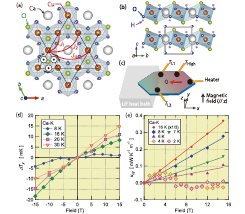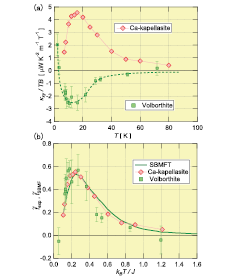Spin Thermal Hall Conductivity in a Kagomé Antiferromagnet
Yamashita and Kawashima Groups
Searching for the ground state of a kagomé Heisenberg antiferromagnet (KHA) has been one of the central issues of condensed-matter physics, because the KHA is expected to host spin-liquid phases with exotic elementary excitations.

Fig. 1. (a, b) Crystal structure of Ca kapellasite viewed along the c axis (a) and the a axis (b). The direction of the Dzyaloshinskii-Moriya interaction (D) is shown by the ⊙ symbols. J1, J2, and Jd (solid red lines) represent the nearest-neighbor, next nearest-neighbor, and diagonal magnetic interactions, respectively [2]. (c) An illustration of our experimental setup. Three thermometers (THigh, TL1, TL2 ) and a heater were attached to the sample. A heat current Q || x was applied within the ab plane and a magnetic field was applied along the c || z axis. (d, e) The field dependence of the transverse temperature difference ΔTy ≡ TL1 − TL2 (d) and κxy (e). Solid lines in (e) represent linear fits.

Fig. 2. (a) The temperature dependence of the thermal Hall conductivity divided by the temperature and the magnetic field (κxy/TB) of Ca-kapellasite [1] and volborthite [4]. (b) Normalized thermal Hall conductivity of these two compounds (f∼exp, symbols) and that of Schwinger-boson mean field theory (f∼ SBMF, solid line) show a remarkable agreement by tuning J and D as fitting parameters. The values of parameters (J/kB, D/J) used for the fittings are (66, 0.12) and (60, -0.07) for Ca kapellasite and volborthite, respectively.
To study the elementary excitations, we investigate the longitudinal (κxx) and transverse (κxy) thermal conductivities of a new candidate of S = 1/2 KHA Ca kapellasite (CaCu3(OH)6Cl2∙0.6H2O) [1]. The magnetic Cu2+ ions in Ca kapellasite form an ideal kagomé structure (Fig. 1 (a) and (b)). The fitting of the temperature dependence of the magnetic susceptibility shows that the spin Hamiltonian in Ca kapellasite is well approximated as an ideal KHA with the effective spin interaction energy J/kB ~ 66 K [1, 2]. Although the ground state is not a quantum spin liquid, the magnetic transition temperature T*~ 7 K is much lower than J/kB, providing a wide temperature range of the spin liquid phase T* < T < J/kB to study the elementary excitations.
Figure 1 (d) shows the field dependence of the transverse temperature difference ΔTy ≡ TL1 − TL2 (see Fig. 1 (c) for the experimental configuration). Remarkably, asymmetric field dependence is clearly observed, demonstrating a thermal Hall signal in this transparent insulator. By asymmetrizing ΔTy with respect to the field direction, we obtain the field dependence of κxy (Fig. 1 (e)) which is found to be linear to the field in the spin liquid phase.
The temperature dependence of κxy/T shows an increase as lowering temperature below J/kB, which is followed by a peak at T ~ J/3kB (Fig. 2 (a)). Quite unexpectedly, the temperature dependence and the magnitude of κxy of Ca kapellasite is similar to that of another kagomé antiferromagnet volborthite [4], whereas the κxx in Ca kapellasite is about one order of magnitude smaller than that of volborthite. Given that κxx is dominated by phonons in this temperature range, similar |κxy| in these kagomé compounds rules out phonons as the origin of κxy.
We find that κxy is well reproduced, both qualitatively and quantitatively, by spin excitations described by the Schwinger-boson mean-field theory [3] with the Dzyaloshinskii-Moriya interaction of D. Most remarkably, both κxy of Ca kapellasite and that of volborthite are found to converge to one single curve of our Schwinger-boson calculation only by choosing J and D as fitting parameters (Fig. 2 (b)). This excellent agreement demonstrates not only that the thermal Hall effect in these kagomé antiferromagnets is caused by spins in the spin liquid phase, but also that the elementary excitations of this spin liquid phase are well described by the bosonic spinons. Although whether our ansatz is the only successful state for describing κxy or other spin liquid states – in particular spin liquids with fermionic spinons having a different κxy – remains an open question, our results suggest that thermal Hall conductivity of a kagomé antiferromagnet has a common temperature dependence described by Schwinger bosons.
References
- [1] H. Doki, M. Akazawa, H.-Y. Lee, J. H. Han, K. Sugii, M. Shimozawa, N. Kawashima, M. Oda, H. Yoshida, and M. Yamashita, Phys. Rev. Lett. 121, 097203 (2018).
- [2] H. Yoshida et al., J. Phys. Soc. Jpn. 86, 033704 (2017).
- [3] H. Lee, J. H. Han, and P. A. Lee, Phys. Rev. B 91, 125413 (2015).
- [4] D. Watanabe et al., Proc. Natl. Acad. Sci. USA 113, 8653 (2016).
